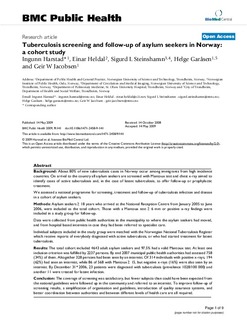| dc.description.abstract | Background: About 80% of new tuberculosis cases in Norway occur among immigrants from high incidence
countries. On arrival to the country all asylum seekers are screened with Mantoux test and chest x-ray aimed to
identify cases of active tuberculosis and, in the case of latent tuberculosis, to offer follow-up or prophylactic
treatment.
We assessed a national programme for screening, treatment and follow-up of tuberculosis infection and disease
in a cohort of asylum seekers.
Methods: Asylum seekers ≥ 18 years who arrived at the National Reception Centre from January 2005 to June
2006, were included as the total cohort. Those with a Mantoux test ≥ 6 mm or positive x-ray findings were
included in a study group for follow-up.
Data were collected from public health authorities in the municipality to where the asylum seekers had moved,
and from hospital based internists in case they had been referred to specialist care.
Individual subjects included in the study group were matched with the Norwegian National Tuberculosis Register
which receive reports of everybody diagnosed with active tuberculosis, or who had started treatment for latent
tuberculosis.
Results: The total cohort included 4643 adult asylum seekers and 97.5% had a valid Mantoux test. At least one
inclusion criterion was fulfilled by 2237 persons. By end 2007 municipal public health authorities had assessed 758
(34%) of them. Altogether 328 persons had been seen by an internist. Of 314 individuals with positive x-rays, 194
(62%) had seen an internist, while 86 of 568 with Mantoux ≥ 15, but negative x-rays (16%) were also seen by an
internist. By December 31st 2006, 23 patients were diagnosed with tuberculosis (prevalence 1028/100 000) and
another 11 were treated for latent infection.
Conclusion: The coverage of screening was satisfactory, but fewer subjects than could have been expected from
the national guidelines were followed up in the community and referred to an internist. To improve follow-up of
screening results, a simplification of organisation and guidelines, introduction of quality assurance systems, and
better coordination between authorities and between different levels of health care are all required. | nb_NO |
